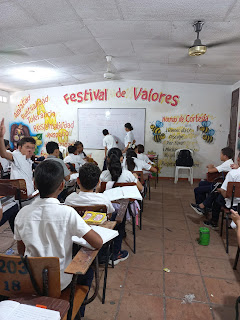Two methods from units 1, 2, and 3.
The direct method
The
Direct Method, also called Natural Method, was established in Germany and
France around 1900. It appeared as an answer to the shortcomings of the Grammar
Translation Method. It is a method for teaching foreign languages that uses the
target language, discarding any use of mother tongue in the classroom.
This method is focused on:
1. Translation is completely banished from any classroom activity. The activities
are carried out only in the target language.
2. Oral teaching comes before any other kind of reading and writing activities.
3. Use of chain activities accompanied by verbal comments like: I go to the door.
I open the door. I close the door. I return to my place. I sit down. (called
the Gouin series)
4. Grammar is taught inductively. (i.e. having learners find out rules through the
presentation of adequate linguistic forms in the target language.)
5. Emphasis is put on correct pronunciation and grammar.
Why is this a
great method?
As
Brown (1973) expressed ¨the Direct Method was quite successful in private
language schools, such as those of the Berlitz chain, where paying clients had
the high motivation and the use of native-speaking teachers was the norm¨ (p.
12).
Another
fact regarding this method is what Krashen and Terrell highlighted (1983) said
¨this method it should be easier to make the meaning clear but not necessarily
be accurate in all details of grammar¨(p. 71).
Finally,
we have what Ozolins (1993) stated about the direct method ¨included a
role-play and simulations based on the language needed to function in specific
situations¨ (p. 206).
Communicative
Language Teaching (CLT)
Communicative
Language Teaching (CLT), which is an approach to the teaching of second and foreign
languages, emphasizes interaction as both the means and the ultimate goal of
learning a language. It is also referred to as the “Communicative Approach”.
Why is this a great method?
CLT
is a holistic approach. It doesn’t focus only on the traditional structural
syllabus. It takes into consideration the communicative dimension of language.
CLT
provides vitality and motivation within the classroom.
CLT
is a learner-centered approach. It capitalizes on the interests and needs of
the learner.
In
a world where communication of information and information technology have
broken new considerable ground, CLT can play an important role in education.




.jpeg)
.jpeg)





.jpeg)









